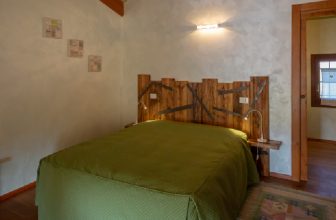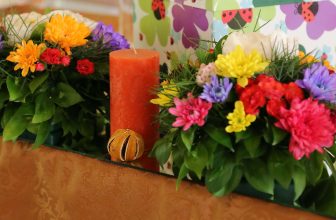How to Decorate Frosted Christmas Tree
Decorating a frosted Christmas tree can transform your living space into a winter wonderland, blending festive cheer with the serene beauty of a snowy landscape. With their delicately snow-kissed branches, Frosted trees offer a unique aesthetic that captures the essence of the holiday season.
Understanding how to decorate frosted Christmas trees is essential to maximizing their magical appeal. This guide will explore the various techniques and creative ideas to help you adorn your frosted tree elegantly and in style.

From selecting a theme that complements the frosty allure to choosing decorations that enhance its snowy appearance, careful planning and creativity play pivotal roles in bringing the festive spirit into your home. Whether you’re aiming for a look that’s timelessly traditional or distinctly modern, the right approach to decorating can make your frosted Christmas tree a captivating centerpiece of your holiday décor.
Selecting a Theme or Color Scheme
When it comes to how to decorate frosted Christmas trees, selecting a cohesive theme or color scheme is your first step toward creating a visually stunning masterpiece. This choice will guide every subsequent decision, from the ornaments to the type of lights you will use, ensuring a harmonious look.
A. Choosing a Theme: Traditional, Rustic, Modern, or Whimsical
Your theme sets the tone for your decorations. A traditional theme might include classic elements like red ornaments and gold trim, evoking a sense of nostalgia and warmth. Rustic decor, on the other hand, leans towards natural materials, muted colors, and handmade ornaments, creating a cozy, cabin-like atmosphere.
A modern theme with minimalist decorations, geometric shapes, and a monochromatic color scheme could be ideal if you prefer a more contemporary look modern theme. Alternatively, a whimsical theme allows for playful and imaginative elements, incorporating bright colors, quirky ornaments, and unexpected textures for a fun and festive tree.
B. Deciding on a Color Palette: Classic Reds and Greens, Silver and Gold, or Non-Traditional Colors
The color palette you choose can complement or contrast with your theme. Classic reds and greens echo the traditional colors of the holiday season, offering a timeless appeal. Silver and gold decorations can add a touch of elegance and sparkle, highlighting the frosted tips of your tree. For those who like to think outside the box, non-traditional colors such as pink, purple, or turquoise can set your tree apart and add a personal touch to your holiday decor.
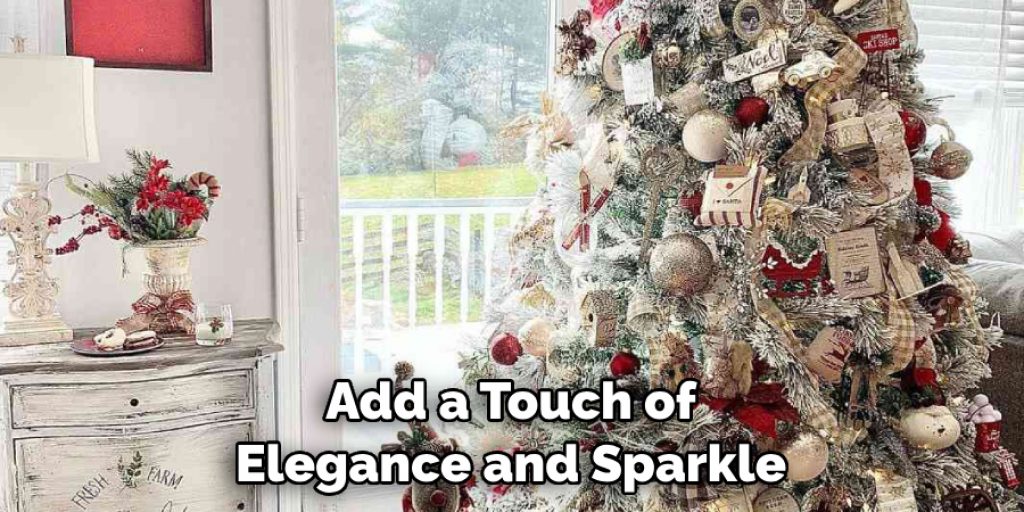
C. Coordinating Decorations: Ensuring Consistency in Ornament Selection and Placement
Once you have settled on a theme and color scheme, the next step is to ensure consistency in your ornament selection and placement. This doesn’t mean all your decorations need to match perfectly, but they should complement each other and contribute to the overall theme. Strike a balance between different sizes, shapes, and textures of ornaments to create depth and interest. Considering the proportions of your tree, begin with larger ornaments, spacing them evenly, before adding smaller accents and finishing touches.
Selecting the right theme and color scheme for your frosted Christmas tree can dramatically enhance its beauty and ensure it becomes the focal point of your holiday decorations. By coordinating your decorations with care, you create not just a tree but a memorable centerpiece that captures the magic of the season.
How to Decorate Frosted Christmas Tree: Adding Lights
Lighting is a pivotal aspect of how to decorate frosted Christmas trees, bringing warmth, depth, and sparkle to the frost-tipped branches. The choice of lights and their placement can significantly influence the ambiance of your tree and overall holiday decor. Here, we explore the nuances of selecting, wrapping, and layering lights to enhance your frosted Christmas tree’s enchanting allure.
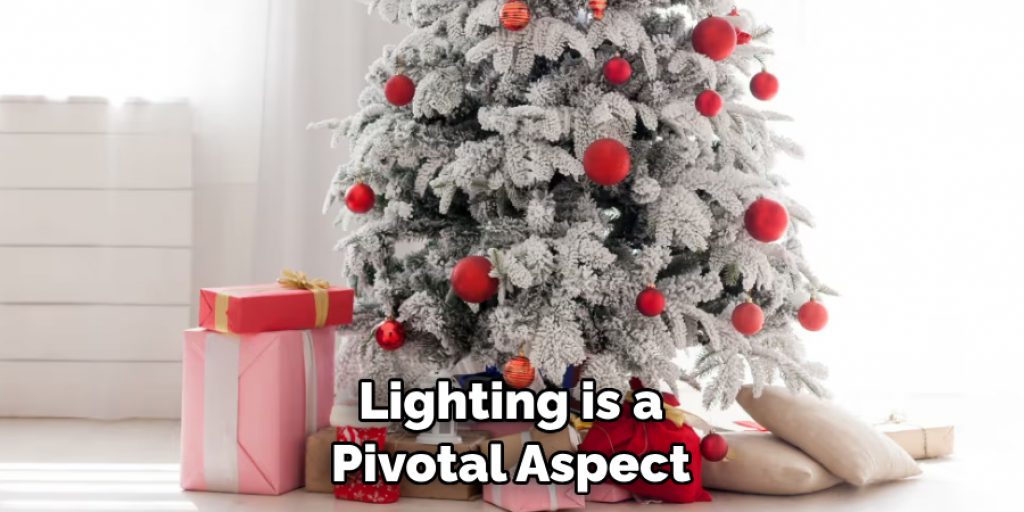
A. Selecting Lights: Clear or Warm White LED Lights for a Soft Glow
The selection of lights sets the tone for your tree’s illumination. Clear or warm white LED lights are recommended for frosted Christmas trees as they mimic the soft, serene glow of moonlight on snow.
LED lights are energy-efficient, emit less heat, and last longer than traditional bulbs, making them a safe and sustainable choice. Warm white lights, in particular, add a cozy and inviting ambiance, complementing the frosty tips of your tree and accentuating its wintery appearance.
B. Wrapping Lights: Distributing Lights Evenly Throughout the Tree, Starting from the Base to the Top
The method of wrapping your tree with lights is crucial for achieving an evenly lit tree that glows from within. Begin at the tree’s base, near the trunk, and work your way up, gently wrapping the branches in a spiral pattern. This technique ensures that the tree is lit uniformly, creating a harmonious and balanced effect. Distribute the lights evenly, paying special attention to the inner branches to add depth and dimension to your tree’s lighting.
C. Layering Lights: Creating Depth and Dimension by Mixing Different Light Sizes and Styles
To elevate the visual interest of your frosted Christmas tree, consider layering lights by mixing different sizes and styles. Incorporate a combination of small fairy lights and larger, globe-style bulbs to create variation and texture.
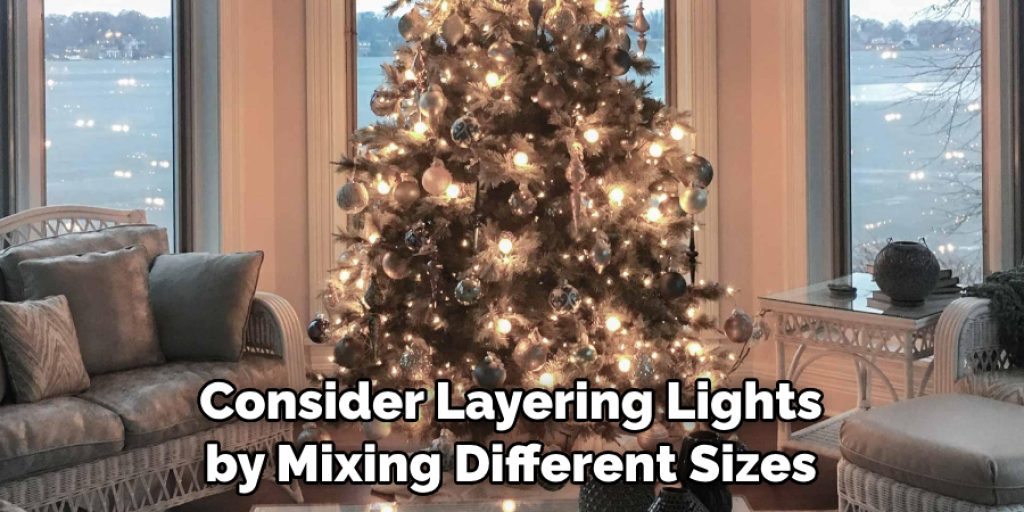
The smaller lights can be nestled closer to the trunk to illuminate the tree from within, while larger bulbs can be placed towards the tips of the branches for added sparkle. This layered lighting approach enhances the tree’s depth and dimension, making it a captivating holiday decor centerpiece.
You can achieve a magical glow that enhances its snowy beauty by thoughtfully selecting, wrapping, and layering lights on your frosted Christmas tree. Warm, well-placed lighting not only highlights the delicate frost but also casts a gentle luminosity that enriches the overall atmosphere of your holiday home.
How to Decorate Frosted Christmas Tree: Decorating with Ornaments
Ornament selection is a key component in dressing your frosted Christmas tree, offering endless possibilities to showcase your personal style while adhering to your chosen theme. Whether opting for classic bulb ornaments, elegant beaded garlands, festive ribbons, or unique handmade decorations, each type contributes to the tree’s overall aesthetic and storytelling.
A. Choosing Ornament Types: Bulb Ornaments, Beaded Garland, Ribbon, or Handmade Decorations
Bulb ornaments are timeless and come in various colors and finishes, allowing for a high degree of personalization within your theme. Beaded garland adds a touch of elegance, gracefully draping between branches for a sophisticated look.
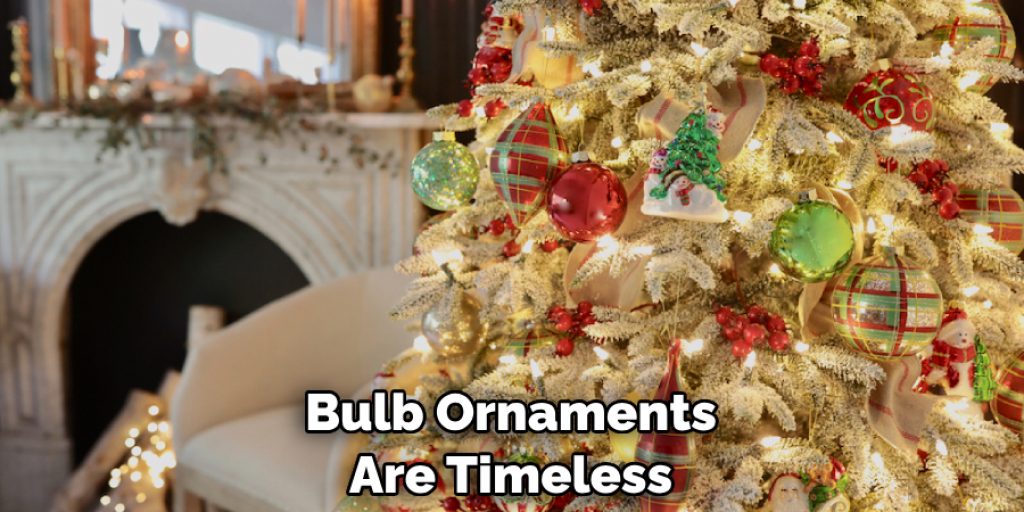
Ribbons, whether used as garlands or bows, introduce texture and flow, adding a dynamic element to the tree’s silhouette. Handmade decorations, on the other hand, infuse the tree with personal significance and charm, making each ornament a memento of creativity and love.
B. Distributing Ornaments: Balancing Colors and Shapes Throughout the Tree, Starting with Larger Ornaments at the Base
Begin by placing the larger ornaments towards the tree’s base, creating a foundation that anchors the overall design. This approach ensures visual balance and optimizes the tree’s shape and proportions.
Gradually transition to smaller ornaments as you move upwards, distributing colors and shapes that encourage the eye to travel, exploring the depth and breadth of the tree’s decoration. This strategic placement enhances the tree’s dimensionality and ensures a cohesive and harmonious appearance.
C. Incorporating Texture: Adding Depth and Visual Interest with Matte, Shiny, and Textured Ornaments
The interplay of texture is fundamental in achieving a visually captivating Christmas tree. Combining matte, shiny, and textured ornaments introduces a rich tapestry of surfaces that interact intriguingly with the tree’s frosting and lighting.
Matte ornaments absorb light, offering a soft, understated elegance, while shiny decorations reflect it, adding sparkle and vivacity. Textured ornaments, be they glittered, flocked, or patterned, introduce complexity and depth, making the tree a focal point of tactile and visual interest.
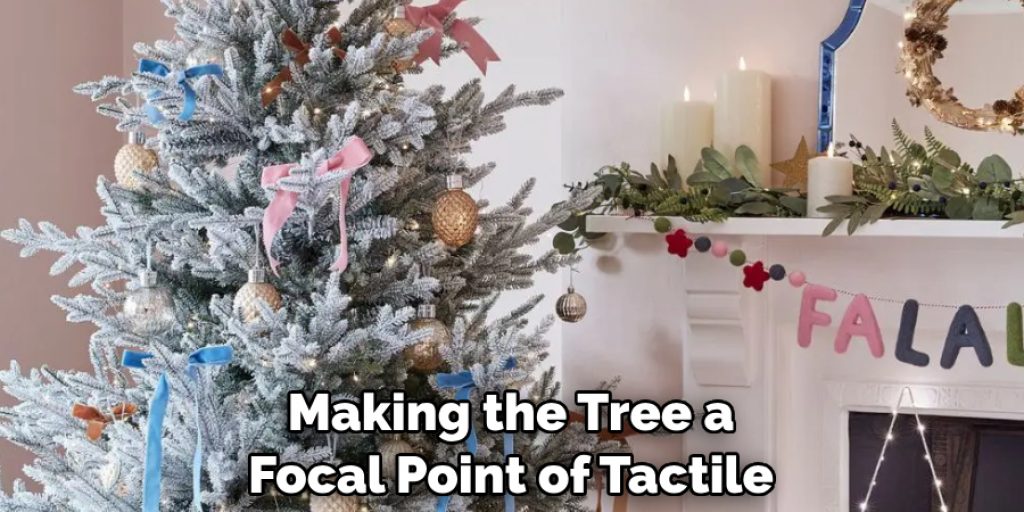
By thoughtfully choosing ornament types, judiciously distributing them across the tree, and creatively incorporating a variety of textures, you can transform your frosted Christmas tree into a stunning centerpiece that celebrates the season’s beauty and your unique take on holiday tradition.
How to Decorate Frosted Christmas Tree: Adding Ribbon or Garland
Adding ribbon or garland to your frosted Christmas tree is a creative way to introduce textures, colors, and additional layers of elegance. These elements can bridge gaps between ornaments, enhance the tree’s theme, and contribute to an overall lushness that makes your tree stand out as a holiday centerpiece. Proper selection and placement of these decorative items can transform your Christmas tree into an enchanting spectacle of holiday cheer.
A. Selecting Ribbon: Wide or Wired Ribbon in Complementary Colors or Patterns
When choosing ribbons for your Christmas tree, opt for wide or wired ribbons that offer flexibility and structure for easy shaping. This type of ribbon can be bent and twisted to hold its shape, allowing for more intricate designs and better control over the final look. Select ribbons in colors or patterns that complement your tree’s color scheme to create a cohesive and harmonious appearance. You could choose ribbons with metallic edges for a touch of sparkle or go for velvet ribbons for a rich, luxurious texture.
B. Draping Ribbon: Weaving Ribbon Vertically or Horizontally Through the Branches for a Cascading Effect
To drape your ribbon effectively, start at the top of the tree and gently weave it in and out of the branches, vertically or horizontally, to create a cascading effect that enhances the tree’s depth. The wired ribbon will allow you to adjust and position it precisely, ensuring it falls gracefully and adds to the tree’s dimensionality. Consider bunching the ribbon at certain intervals or creating loops before securing them to branches with tiny clips or ties for a fuller look.
C. Using Garland: Tinsel, Beaded, or Faux Pine Garland to Fill Gaps and Add Sparkle
Garlands offer a different texture and form, helping to fill in gaps between branches and ornaments. Tinsel garland adds shimmer and reflects the lights beautifully, creating a magical sparkle that complements the frosted tips of the branches.
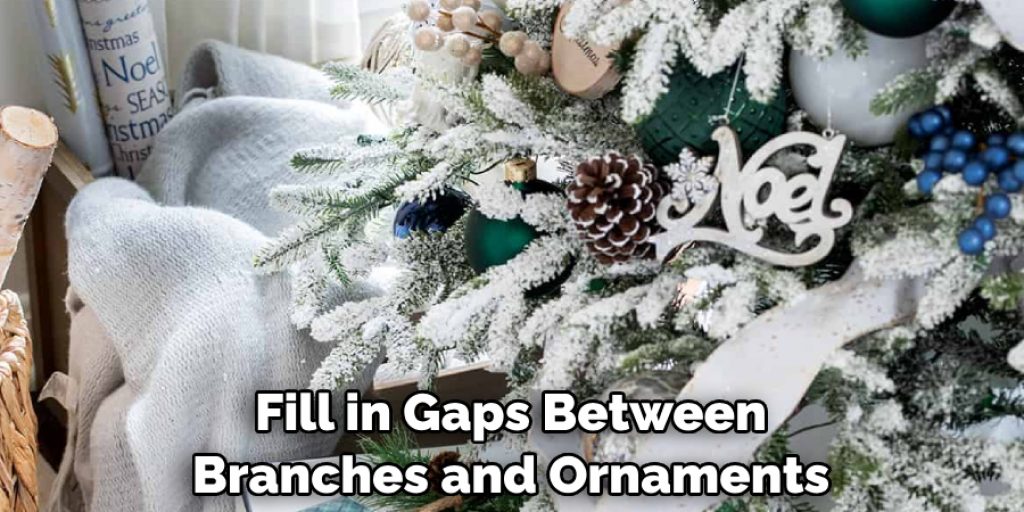
Beaded garland, on the other hand, brings elegance and sophistication, contributing a touch of gleam that enhances the tree’s visual interest. Faux pine garland can be used to add fullness and a touch of realism, particularly in areas where the tree may appear sparse. By intertwining these garlands with the ribbon or layering them separately, you can achieve a rich, full look that captivates and delights.
Integrating ribbon or garland into your Christmas tree decoration strategy enriches the overall aesthetic, blending textures and colors to achieve a festive, eye-catching display. Through careful selection and thoughtful placement, these elements can elevate the visual impact of your frosted Christmas tree, making it a remarkable highlight of your holiday decor.
Incorporating Natural Elements
Adding elements of nature to your frosted Christmas tree decoration adds a layer of authenticity and rustic charm that beautifully complements the frosted effect. Natural decorations like pine cones, foliage, and berries enhance the tree’s aesthetic and connect the indoor holiday celebration with the outdoor winter landscape.
A. Adding Pine Cones: Nestling Pine Cones Throughout the Tree for a Woodland Touch
Strategically placing pine cones among the branches introduces a woodland touch to your Christmas tree, creating a sense of natural beauty and simplicity. You can gather pine cones from nature walks or purchase them from craft stores. Consider varying the sizes and tones of the pine cones to add depth and interest. For extra holiday sparkle, you can lightly dust the pine cones with glitter or faux snow before nestling them into the tree.
B. Using Foliage: Sprigs of Pine, Cedar, or Holly for Fragrance and Texture
Incorporating sprigs of pine, cedar, or holly among the ornaments adds layers of texture and a fresh, festive fragrance to your tree. The greenery can be real or artificial, depending on availability and preference. Real foliage must be replaced periodically to maintain its freshness, while artificial options offer lasting beauty. These sprigs can be tucked into the tree at various angles to mimic how they might appear in a natural setting, enhancing their depth and fullness.
C. Decorating with Berries: Faux or Dried Berries for Color and Interest
Adding clusters of faux or dried berries among the branches introduces pops of color and interest, creating focal points throughout the tree. Choose from red, white, or even metallic berries to complement your tree’s color scheme. Berries can be attached to sprigs of foliage for a more cohesive look or used independently for a subtle hint of color among the other decorations.
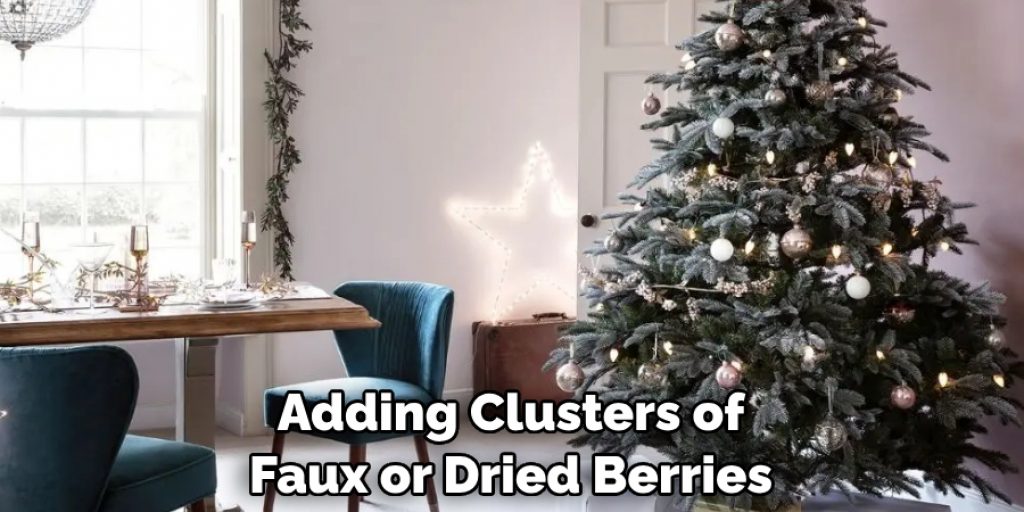
Incorporating these natural elements into your frosted Christmas tree design pays homage to the beauty of the winter landscape and adds a unique and personalized touch to your holiday decor.
Personalizing with Keepsakes
Infusing your Christmas tree with a collection of keepsakes can transform it from a standard holiday decoration into a deeply personal showcase of family history and individuality. These personal touches add unique character to the tree and serve as reminders of cherished memories and loved ones during the festive season.
A. Displaying Family Ornaments
Incorporating handmade or sentimental ornaments that have been passed down through generations is a beautiful way to honor family traditions and history. Each piece tells a story, whether it’s a bauble crafted in a child’s early years or an heirloom ornament from a great-grandparent. Displaying these items prominently on your tree ties the past to the present and offers a sense of continuity and belonging.
B. Adding Personal Touches
Creating or purchasing personalized ornaments such as DIY crafts, monogrammed baubles, or photo ornaments adds another layer of individuality to your tree. These can mark significant milestones, celebrate new additions to the family, or simply express the personalities and interests of family members. Engaging in DIY ornament projects or selecting special pieces each year can become a cherished holiday activity in itself.
C. Creating Memories
The act of decorating the Christmas tree offers a perfect opportunity to involve family and friends, turning it into a special tradition that builds lifelong memories. Sharing stories behind the keepsakes, recounting memories associated with particular ornaments, and enjoying the collective effort of dressing the tree fosters a sense of unity and warmth. This collaborative process beautifies the tree, strengthens bonds, and creates new moments to cherish.
By weaving keepsakes, personal touches, and shared experiences into the fabric of your Christmas tree decoration, you create a uniquely meaningful and beautiful holiday centerpiece that reflects the hearts and histories of those who gather around it.
Topping the Tree
The crowning glory of any Christmas tree is its topper, a symbolic piece that completes the festive masterpiece. Choosing the right topper is crucial, as it draws the eye upward and encapsulates the tree’s theme and essence.

A. Choosing a Tree Topper: Traditional Star or Angel, Bow, Snowflake, or Unique Ornament
When selecting a tree topper, consider your tree’s overall style and theme. Traditional options include the star, symbolizing the Star of Bethlehem, and the angel, representing the angelic figures of the Nativity story. Both evoke a sense of classic Christmas warmth and spirit.
For a more contemporary look, a large bow, an intricate snowflake, or even a unique ornament that reflects a personal hobby or interest can serve as an eye-catching alternative. The key is ensuring the topper resonates with the rest of the tree’s décor and the room’s ambiance.
B. Securing the Topper: Ensuring Stability and Balance on the Tree’s Apex
Securing the topper firmly is essential to prevent it from toppling over. Most toppers come with spiral bases or cones that can be easily nestled into the tree’s apex, but ensuring a snug fit may require additional support. Lightweight wire or clear fishing line can be used to tie the topper to the uppermost branches, offering stability without detracting from its appearance. Consider the balance of the topper as well, as a heavy ornament may require rearranging the top branches to distribute the weight evenly.
C. Making a Statement: Selecting a Topper that Complements the Overall Theme and Style of the Tree
Your tree topper is more than just an ornament; it’s a statement piece that should harmonize with the theme of your tree. Whether opting for a traditional angel, a playful snowflake, or a bespoke creation, the topper should accentuate the tree’s design, color scheme, and lighting. It marks the culmination of your decorating effort, symbolizing the joy and peak of the holiday season. By selecting a topper that complements your tree’s overall theme and style, you ensure a visually stunning and cohesive Christmas display that captivates and delights everyone who beholds it.
Final Touches and Adjustments
Once the ornaments are hung, the lights are draped, and the topper is firmly secured, the final touches and adjustments become crucial to perfecting your Christmas tree’s charm.
A. Stepping Back to Assess: Viewing the Tree from Different Angles to Ensure Balance and Symmetry
The importance of stepping back to view the tree from various angles cannot be overstated. This perspective helps to assess the distribution of ornaments and lights, ensuring that balance and symmetry are achieved. It’s easy to get caught up in the details while decorating, so this broader view is essential for spotting any areas that may be too crowded or sparse.
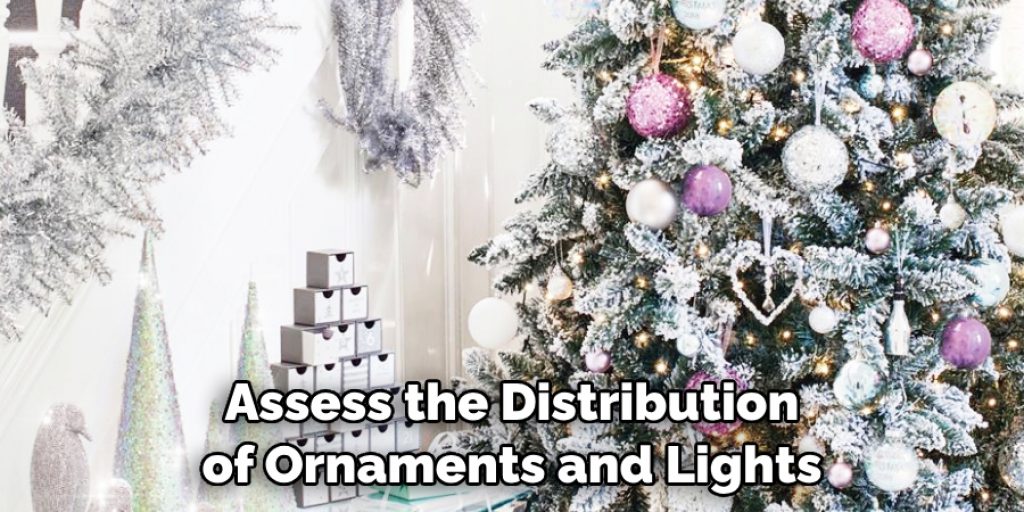
B. Making Adjustments: Rearranging Ornaments, Lights, or Decorations to Fill Gaps and Create Cohesion
After the initial assessment, don’t hesitate to make adjustments. Rearranging ornaments, lights, or other decorations to fill any noticeable gaps will enhance the tree’s overall cohesion. This process might involve moving larger ornaments to prominent positions while tucking smaller ones into deeper parts of the branches to create depth and interest.
C. Adding Tree Skirt: Completing the Look with a Coordinating Tree Skirt or Blanket
Finally, no Christmas tree is complete without a tree skirt or a beautifully draped blanket at its base. Not only does this element finish the tree’s look, but it also ties together the decoration theme, adds color, and hides any less aesthetic parts of the tree stand. Choose a skirt or blanket that complements the tree’s color scheme and overall style, serving as the perfect backdrop for presents or as a cozy touch that enhances the festive spirit.
Conclusion
We’ve explored comprehensive strategies on how to decorate frosted christmas tree, from selecting a thematic color palette to incorporating personal and meaningful ornaments. Each step, including the placement of lights, choosing and securing the perfect tree topper, and ensuring the tree presents a balanced and symmetrical appearance, contributes to creating a visually stunning holiday centerpiece.
This guide encourages you to infuse your personality and creativity into every ornament placement and decision made during decoration. Remember, there is no single right way to decorate your tree. It’s an opportunity to express oneself freely and bond with loved ones over shared moments of joy.
We wish you a delightful decorating experience and a holiday season that’s as merry and bright as your beautifully adorned, frosted Christmas tree. May this guide on how to decorate frosted christmas tree inspire you to create a festive atmosphere filled with joy, laughter, and unforgettable memories. Happy Holidays!

